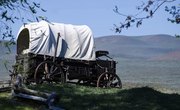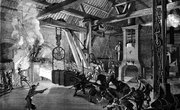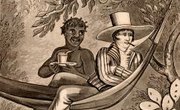A chandler is a purveyor of retail goods such as wax or groceries. The word has come to mean a seller and supplier of a specific industry’s needs, such as a ship’s chandler. Originally, though, a chandler was a craftsman who made candles, an important trade in the days before electric lighting. In Medieval times, the profession had expanded to include the selling of other goods besides candles.
A Chandler’s Home and Workplace
Like many working-class people of Medieval Europe, some chandlers lived on nobles’ estates and traveled to towns to sell their wares in bazaars and fairs. Many chandlers lived in towns near or above their shops. Towns were cramped with stone or wood houses built close together or actually sharing walls. Their homes often had little furniture and few windows. Families shared sleeping areas and several children shared the same bed. Household waste, including sewage, was dumped into the streets, and tradesmen, including chandlers, dumped their shop waste into the local waterways.
Tallow Chandlers
There were two types of chandlers: tallow chandlers and wax chandlers. Tallow chandlers worked mainly with beef or sheep fat that was melted and strained. Twisted or braided cotton strands (wicks) were dipped into the tallow, allowed to cool, then dipped again and again until they were the desired size. Tallow chandlery was often a side business of butchers. Tallow retained much of the smell of the animal both during the production of the candle and when it was burned, so tallow was considered less desirable than beeswax as candle-making material. Some tallow chandlers also produced soaps. Because of the smelly environment, tallow chandleries were avoided by most people, but the products were in high demand.
Wax Chandlers
Beeswax candles burned with very little smoke or odor, so they were preferred by those who could afford them. The Church insisted on them, as did the aristocracy, making beeswax chandlery a lucrative business. The process of making beeswax candles was similar to that of tallow candles -- minus the stench. Beekeepers were sometimes also wax chandlers, and both professions were part of the confectioners and spice sellers trades. Chandlers who kept bees often lived in rural areas close to town to keep an eye on their hives.
The Business of Chandlery
Candles were critical necessities in Medieval Europe, making chandlery an important trade. Some entrepreneurial chandlers were successful businessmen, especially after they began selling other goods. This wealth allowed some to move to the country, purchase land and to hire apprentices to produce candles and manage shops. Women sometimes inherited shops after their husbands died and were allowed to join chandlers’ guilds.
Chandlers’ Guilds
Guilds were organizations of craftsmen that formed in the early Middle Ages to regulate trades and provide tradesmen a voice in local governments. The guilds provided structure to apprenticeships and training, enforced quality standards, consolidated bargaining with suppliers and vendors, and protected craftsmen from competition from their former apprentices. They were in some ways the precursor to labor unions. Chandlers had a choice of guilds, including ones for tallow or wax chandlers. Some of these guilds, such as the Wax Chandlers Company, have survived as retail companies and charitable organizations.
Related Articles
References
- Medieval Towns, Trade, and Travel
- The Book of English Trades: The Tallow-Chandler
- Medieval London Guilds - Candle making guildss
- Commercial Activity, Markets and Entrepreneurs in the Middle Ages
- The Journal of Economic History: Craft Guilds, Apprenticeship, and Technological Change in Preindustrial Europe
Resources
Writer Bio
Dee Shneiderman, former librarian and paralegal, has been writing for 40+ years. Published in Compute! Magazine, she helped found The Crescent Review literary magazine. Owner of Frugal-Foto Photography, she holds a Bachelor of Arts in English, a Master of Library Science and a North Carolina Truck Driver Training certificate.











